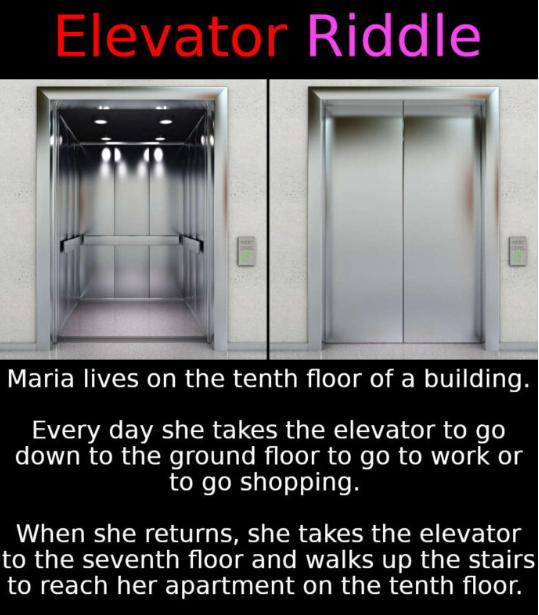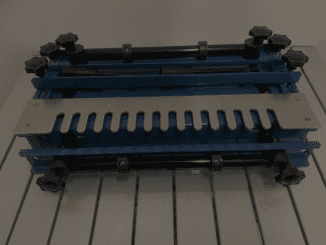Maria lives on the tenth floor of her building. Each day, she faces a peculiar problem. While she can easily take the elevator down to the ground floor, when she returns home, she only takes the elevator to the seventh floor and then walks up three flights of stairs to her apartment on the tenth floor. This seemingly strange behavior might confuse many, but there’s a simple and logical explanation behind it.

Why Maria Stops at the Seventh Floor
At first glance, you may wonder why anyone would stop at the seventh floor when they could ride the elevator all the way up to the tenth floor. After all, if Maria doesn’t enjoy walking, why would she willingly take the stairs for three floors? The key to understanding this riddle lies in Maria’s physical attributes.
The Answer: Maria is Short
Maria’s unusual elevator habit is explained by the fact that she is short. This simple detail changes everything. You see, the elevator buttons for floors eight, nine, and ten are located higher than she can reach. While she can easily press the button for the ground floor when she’s leaving, reaching the buttons for the upper floors is beyond her grasp when she returns home. So, she presses the highest button she can reach—the one for the seventh floor—and then walks the rest of the way.
Elevator Design: A Challenge for Shorter People
Elevators are designed to accommodate people of different heights, but in some older or less user-friendly designs, the upper buttons may be positioned too high for shorter individuals to comfortably reach. Maria, being of shorter stature, faces this common challenge. While modern elevators often have more accessible button layouts, in some cases, especially in older buildings, this inconvenience remains.
For someone like Maria, the inability to press the higher-floor buttons forces her to stop earlier than she would like and take the stairs, even though she dislikes walking.
Why Not Ask for Help?
You might be wondering, “Why doesn’t Maria just ask someone taller to help her press the buttons when she gets in the elevator?” While that could be a solution, it’s not always practical. There may not always be someone else in the elevator, and waiting for assistance every time she returns home would be inconvenient. Instead, Maria has adapted to the situation by stopping at the seventh floor and making her way up on foot. It’s a small inconvenience, but one she’s grown accustomed to.
The Psychological Twist
Maria’s riddle also highlights something about human nature: how we adapt to challenges in our daily lives. Rather than viewing her situation as a problem, Maria has found a workaround that suits her routine. This small adjustment speaks to the ways in which we cope with inconveniences in life, often without even realizing it. Maria’s willingness to walk the final three floors instead of seeking help or using another method reflects her ability to adapt and take control of her situation, despite the minor discomfort.
A Lesson in Observation and Problem Solving
This riddle is a perfect example of how sometimes the most perplexing problems have the simplest solutions. Many might initially assume Maria’s behavior is strange or illogical, but once you consider her height and the elevator’s button placement, everything makes perfect sense.
It’s a reminder that when faced with a puzzling situation, it’s important to consider all factors, even those that seem insignificant at first glance. Often, the smallest details—like a person’s height—can hold the key to solving the mystery.

Other Similar Elevator Riddles
Maria’s riddle isn’t the only one of its kind. There are many variations of elevator-related puzzles that play on similar themes. For example, another classic version involves a person who only takes the elevator halfway up and uses a walking stick to press the higher buttons. These riddles share the common trait of presenting an unusual scenario that seems illogical until you focus on the specific details, like a physical limitation or an overlooked fact.
Conclusion: The Simplicity of the Solution
In the end, Maria’s elevator riddle is a fun and clever puzzle that reminds us not to overlook the small details. The answer is not only logical but also relatable, highlighting a challenge that some individuals might face in everyday life. Maria’s height may prevent her from reaching the upper buttons in the elevator, but it doesn’t stop her from finding a solution that works for her. Through this riddle, we are reminded that sometimes the answers we seek are right in front of us—all we need to do is look a little closer.


